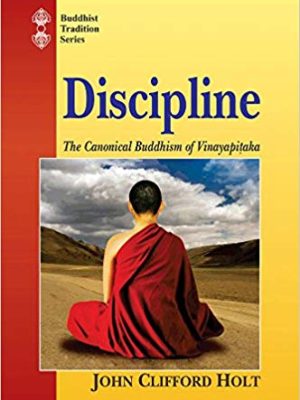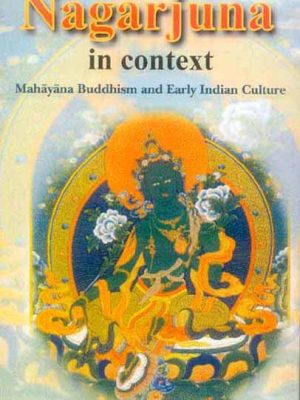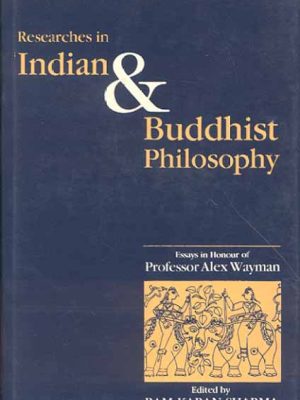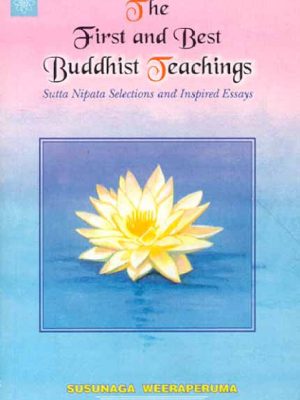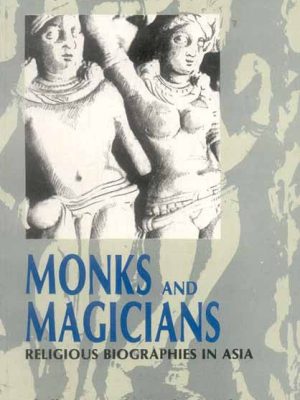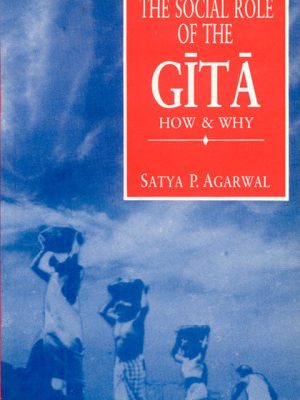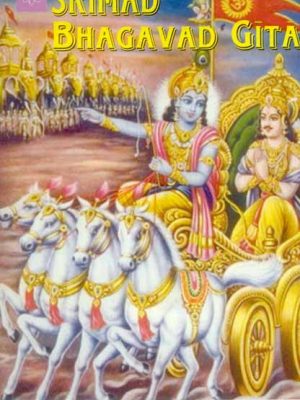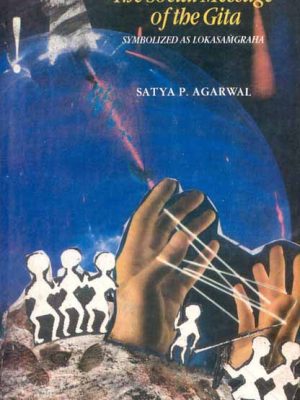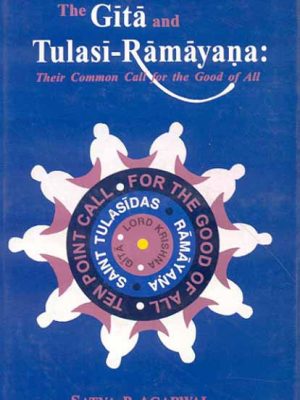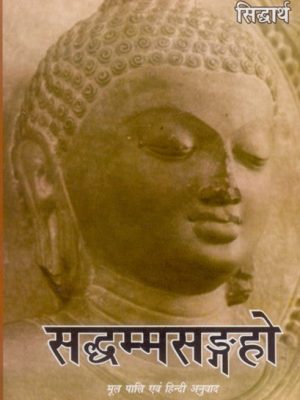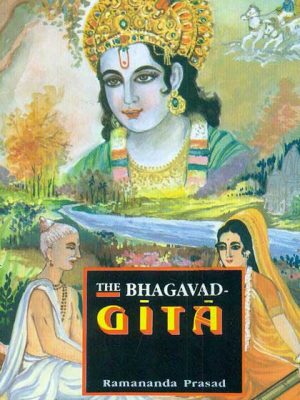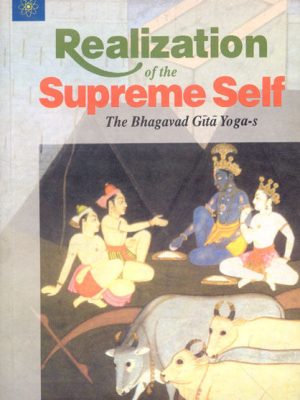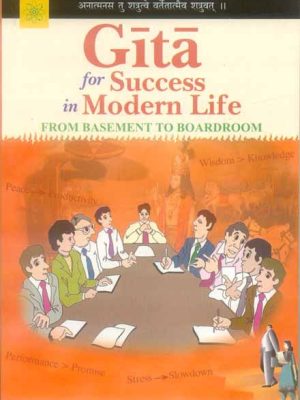Bhagavad Gita
Bhagavad Gita is a way of life. In the battle of Mahabharata, when Arjuna is unable to fight against his relatives, Shri Krishna guides him through the right path. The teachings of Shri Krishna guide not only Arjuna but the rest of humanity through every battle of life. Bhagavad Gita helps us to be a better version of ourselves. few books from this collection are Srimadbhagavadgita, Selections from the Mahabharata: Re-affirming Gita’s Call for the Good of All, and Shrimadbhagavat Ka Gyan.
-
From Mind to Super Mind: A Commentary on Bhagavad Gita
The message of the Gita has an important and a practical bearing on the problems of the modern age. It shows a way out of the complexities of the mind to complete and unfettered freedom of the Super-Mind. This path is not meant only for the few, it can be trodden by all who seek freedom from life’s entanglements. In an age where the individual is becoming more and more insignificant due to the impacts of political, economic and social forces, the Gita brings to man a message of hope and cheer, for it shows a way of life which leads to the regaining of his lost significance, and the spiritual regeneration of man is indeed the way to the creation of a happy society.
About the Author:
ROHIT MEHTA was a founder of the Congress Socialist group in 1934. He travelled widely in almost all parts of the world as a lecturer speaking on Religion, Philosophy, Yoga, Psychology, Education, etc. Mehta was a founder of the congress socialist group in 1934 which later on became the socialsit party of India. But while he accepted the economics of socialist Party of India. But while he accepted the economics of socialism he was deeply dissatisfied with the philosophy of socialism. This led him to become an active worker in the Theosophical society. He became an International secretary of the society when Dr. G.S. Arundale was the president.
₹295.00 – ₹495.00From Mind to Super Mind: A Commentary on Bhagavad Gita
₹295.00 – ₹495.00 -
Astavakragita: The Song of the Self Supreme
Astavakragita (The Song of the Self Supreme) contains the Sanskrit text of Astavakragita (both in Nagari and Roman script), its English translation, Exegesis and Glossarial Index. It presents in twenty chapters the substance of Astavakra’s teaching in respect of the Cosmic Self in the form of his dialogue with Janaka, the seer-king of Videha. The teaching is based on the Upanisadic creed of Absolute monism (Advaitavada) that identifies the Self with the non-dual Ultimate Reality. But the contribution of Astavakra is also immense, for he has introduced the element of emotional experience or the mystical feeling as the means for realizing the non-dual nature of the Self. Written in a lucid style and dealing systematically with the subject matter, the book will hold a unique position among the contemplative classics of the world.
Review(s)
The English translation is faithful to the Sanskrit original and the annotations by the editor are extremely illuminating and helpful. Altogether, this book is a treasure house of Advaita thought and should be in the hands of every sincere student of phil
₹295.00 – ₹495.00Astavakragita: The Song of the Self Supreme
₹295.00 – ₹495.00 -
-
The Social Role of the Gita: How and Why
Although the Bhagavad-gita has traditionally been regarded as a poem of primarily religious significance, Dr. Agarwal shows that with the proper interpretation its message may be ransformed into a set of practical ethical guidelines. This practical aspect of the Gitaês teaching, its insistence that involvement with the world is an ethically correct function of human behaviour, is the focus of this book. That involvement with the worldês is expressed by the term ‘Lokasamgraha’. The term covers a multitude of social and political forms of behaviour and attitudes of mind and is perhaps more central to the meaning the Gita should have for modern man than its traditional other-worldly interpretation.
Dr. Agarwal has examined the various ways in which India has reacted to the impact of many powerful foreign influences over the past two centuries. He has done so by studying the lives and the activities of select Hindu thinkers who through their writings and their ways of life showed their awareness of a need to preserve an Indian identity. All of them undertook to define these differences and thus established their views on what might be acceptable alternatives for India and the Indian genius vis-a-vis those principles and customs that run counter to the Indian tradition. But they were not unanimous in either their conclusions or the strategies they devised for attaining their common goal. The author has concentrated on the role the Bhagavad-gita has played in the lives and works of these thinkers.
Review(s)
About the Author(s)
Dr. Satya P. Agarwal is a Social Scientist. His academic honours include five gold medals and numerous merit scholarships and research fellowships at various universities. The Governor of the State of Maryland conferred upon him “The Governor’s Citation”, in recognition of his pioneering books as also his contribution to social service. He is author of several books besides the present one which are widely acclaimed and appreciated by the discerning readers. Other honours conferred on him include: (i) Kunti Goyal International Award, (ii) Special Award of Manas Sangam and (iii) International Tulasi Award.
₹395.00 -
Srimad Bhagavad Gita
Srimad Bhagavad Gita presents “The Sermons from the Illustrious Lord Krsna to Arjuna,” compiled by the great ancient seer, Vyasa. Here is a rendering of Srimad Bhagavad Gita into English. While translating from Sanskrit into English, the author has spent about ten years in first realizing and then choosing the exact equivalent English words for translation so that the beauty, substance, meanings, dignity and grace of the original is not disturbed. Though the melody and magic of the verses is difficult to recapture in another medium, yet the author has tried his utmost to bring it in its best. To feel the dignity of phrase and the intensity of utterance, the author has given the text in Roman script so that those who know Sanskrit can enjoy its fullness while pondering over in its original, whereas others who do not know Sanskrit also get a fairly correct idea of the spirit of the poem. After putting up the text in Roman, it has been rearranged to facilitate the meaning of the verse. Then appear the word-for-word meaning and lastly the verse has been translated into English as exactly as possible so as not to deviate at all from its original.
Review(s)
About the Author(s)
Kailash Nath Kalia was born in Talwan (Punjab) and became increasingly interested in Indian philosophy during his active participation in the struggle for Indian independence. In 1950, he joined the Vishveshvaranand Vedic Research Institute (Hoshiarpur, Punjab), serving as its Assistant Director. In 1966 he moved to the United Kingdom and founded the Vivekananda Centre, a charitable organisation whose ethos allied service to spirituality. The Bhagavad Gita was fundamental to the author’s lifelong charitable work and service. He believed that the Gita’s inspirational teachings provided spiritual guidance for the individual and enabled mutual respect and understanding between people. Kailash Nath Kalia passed away on June 23, 1989. This book has been prepared posthumously from the manuscript he left behind. It is hoped that this work will help to disseminate the Gita’s message of universal harmony and spiritual enlightenment and so fulfil his cherished wish. *The author’s proceeds will be donated to charity.*
₹395.00Srimad Bhagavad Gita
₹395.00 -
The Social Message of the Gita Symbolized as Lokasamgraha: (Self Composed Skt. Slokas with Eng. Comm.)
This book is a landmark in the wide panorama of Gita Literature, the universal nature of which is reflected in the use- in the form of prose as well as poetry-of an increasing number of the world’s languages. As the first book to utilize original verses in modern Sanskrit to convey the social massage of the Gita, it not only fills a significant linguistic gap but also focuses attention on social issues which call for urgent action by karmayogins.
Review(s)
About the Author(s)
Dr. Satya P. Agarwal is a Social Scientist. His academic honours include five gold medals and numerous merit scholarships and research fellowships at various universities. The Governor of the State of Maryland conferred upon him “The Governor’s Citation”, in recognition of his pioneering books as also his contribution to social service. He is author of several books besides the present one which are widely acclaimed and appreciated by the discerning readers. Other honours conferred on him include: (i) Kunti Goyal International Award, (ii) Special Award of Manas Sangam and (iii) International Tulasi Award.
₹395.00 -
The Gita and Tulasi-Ramayana: Their Common Call for the Good of All
This book has identified “the good of all” as the single most important criterion of excellence of any socio-spiritual approach to life’s problems–particularly in the context of the conflict-ridden society of today. The comprehensive coverage of this criterion, as presented in this study, has strong links with (like Ganga, Yamuna, and Saraswati) three life-sustaining streams of thought. The first stream refers to the lokasamgraha-message of the Gita which has been formulated in that scripture from ten different but inter-connected angles. The second stream refers to the jagmangal-message of the Manas which is simpler to grasp and which can also be explained from the same ten angles as applied to the Gita. The third stream refers to the repeated expressions of the concern for “the good of all” which began with the Vedas and which continued as an integral part of the Indian tradition–a steady source that strengthened the calls of the Gita and Manas also.
By putting all these ideas together and by maintaining the interest of the readers, this book has opened the door to a new field of study and research, viz. the Indian contribution to the theory and practice of “the good of all.”
Review(s)
“His arguments are forceful and convincing. The book is a gem which is worth acquiring by all those interested in the subject.”
NATIONAL HERALD
About the Author(s)
Dr. Satya P. Agarwal is a Social Scientist. His academic honors include five gold medals and numerous merit scholarships and research fellowships at various universities. The Governor of the State of Maryland conferred upon him “The Governor’s Citation”, in recognition of his pioneering books as also his contribution to social service. He is the author of several books besides the present one which are widely acclaimed and appreciated by discerning readers. Other honors conferred on him include (i) the Kunti Goyal International Award, (ii) the Special Award of Manas Sangam, and (iii) the International Tulasi Award.
₹395.00 -
-
-
-
The Bhagavad-Gita: The Song of God: Original Sanskrit text & Roman Transliteration, A lucid english rendition,
The Gita is a song-not just any song, but a very special song, the song of God-sung by the
Divine Being of infinite consciousness to His most beloved devotee, Arjuna. Arjuna in Sanskrit means clear white light, the brightness and clarity, the name of the man who manifested the clarity of pure devotion by which the Lord’s wisdom may be heard, and by which the universal form may be perceived. And what a song it is! A symphony of soul’s longing for divinity, of the search for clarity, the explanations of yoga-what constitutes divine union, and how one gets there. No
subject of spiritual evolution remains neglected by the Gita.
The Gita has been translated into more languages than any other literary work. In English
alone there are more renditions than can be counted. Each one has its own character, each one
a slightly different analysis. Some are poetic, some philosophical, some dogmatic, some universal.
This translation by Dr. Prasad is just beautiful-so simple and clear. He uses just enough sanskrit to convey the majesty and beauty of the language and the intensity of the dialogue, and yet does not leave the reader dumbfounded in an unintelligible maze of vocabulary. The universal principle of the philosophy he espouses are filled with poetic grace and style. He captures so much of the Grace of the Gita, even in the prose of English, that the orchestrations of wisdom cannot but help lull our hearts after every chapter.
From Confusion’s first desire to neglect one’s duty or responsibilities, to the infinite vision of
the Lord as a consequence of total surrender to the will of God, Prasad’s rendering takes the
reader from doubts and misgivings to perfect efficiency in all that one undertakes.
The Bhagavad-Gita has the original Sanskrit text with Roman transliteration, and a lucid English rendition. Concise and to the point commentaries on two hundred twenty-seven selected key verses are provided. One hundred thirty three verses are printed in red to enable the first-time readers to study these verses before delving deep into the vast ocean of transcendental knowledge. The teachings of saints and sages of major religious denominations as well as world leaders and scholars have been included. Quotations from the Vedas, Puranas, Upanisads, Smrtis, Ramayana, Mahabharata, Bhakti-sutras, Brahma-sutra, Yoga-sutra, as well as other major scriptures of the world such as the Bible, Dhammapad and Koran have been incorporated to underline the basic unity of all religious thoughts and to promote the universal brotherhood of mankind. Epilogue, references, Sanskrit transliteration and pronuciation guide, glossary and index are provided. A guide to meditation, beautiful pictures and Gita Calisa are included for daily Sadhana.
Review(s)
“The Gita is a doctrine of universal truth, the Sanatana dharma, commonly known as Hinduism. It has the capacity to come down to the level of the reader and raise him to peace of mind.” – The Adyar Library Bulletin-1996 – K.K. Raja
The originally of the author/compiler lies in providing a suitable glass on all the important stanzas. While doing this, he has drawn upon authentic sources of Indian philosophy and history, and has juxtaposed quotes from the teachings of other religions. – Prabuddha Bharata Vol.102, December 1997 – Dr. Narendranath B. Patil, Mumbai
About the Author(s)
The gita is a doctrine of universal truth, the Sanatana dharma, commonly known as Hinduism. It has the capacity to come down to the level of the reader and raise him to peace of mind. (The Adyar Library Bulletin-1996) -KK. Raja, The originality of the author/compiler lies in providing a suitable gloss on all the important stanzas. While doing this, he has drawn upon authentic sources of Indian philosophy and history, and has juxtaposed quotes from the teachings of other religions. (Prabuddha Bharata, Vol 102, Dec. 1997) -Dr. Narendranath B. Patil, Mumbai.
₹295.00 -
The Bhagavad Gita: A Transcreation of the song celestial
The Bhagavad Gita is one of the world’s greatest scriptures, the key sacred text of Hinduism. It means the ‘Song of God’ and is often called the ‘Song Celestial’. Alan Jacobs has succeeded in revitalizing the ancient text into a form which reveals the full majesty of the magnificent scriptures as well as its practical message for today’s seekers. The outdated English of Sir Edwin Arnold’s fine poetic translation in 1885 has been trasnsformed and given clear meaning. It has also been expanded to reinforce the poetic imagery using cotemporary free verse based on innovative metaphors. “It is like a great symphony. each chapter relates to the last but leads on to the coda.”
Review(s)
About the Author(s)
₹295.00 -
Realization of the Supreme Self: The Bhagavad Gita Yogas
This book presents the Gita yoga in the light of explanations by Sankara.
The Gita can be misread, as Sankara says. It is not a gradual ascent to the
final devotion of the sould to a Lord high above. The whole basis of Gita
yoga is confirmation through experiments. not mere exhortion. This highly
significant book presents the Gita as a training manual for spiritual
practice.
Review(s)
About the Author(s)
₹295.00 -
Gita For Success In Modern Life: From Basement to Board Room
This book underscores that the Gita is not for abandoning active life but for reconstructing.
The book focuses particularly on the modern man. It does not deal with an imaginary or an ideal situation but with man’s real life. It recognises that man is caught up in a whirlpool of conflicting values and tries to resolve and reconcile them. The book explores various dimensions of man’s life – as an individual, as a family member, as a social being and as a businessman, as well.
The book selects only a few chapters and shlokas and brings out the principal teachings of the Gita which are of direct relevance in the context of contemporary modern life.
Review(s)
“Parables and metaphors in the Gita have been used as in other ancient scritures and literature to explain the subtle meanings in a simple manner to the reader……Separate chapters have been devoted to different ingredients of Karma Yoga……A Pe
About the Author(s)
₹250.00
